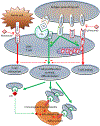Kidney Complications of Immune Checkpoint Inhibitors: A Review
- PMID: 31303350
- PMCID: PMC6756976
- DOI: 10.1053/j.ajkd.2019.03.433
Kidney Complications of Immune Checkpoint Inhibitors: A Review
Abstract
Immunologic control of malignancy has long been recognized as an important determinant of disease progression. Recent advances in immunology have led to the focus on several mechanisms that can be targeted to achieve tumor suppression. In particular, checkpoint inhibition has evolved in less than a decade to become one of the most important strategies in cancer therapy, with a meaningful improvement in patient survival. Six agents have been approved for clinical use to date and many more are in the industry pipeline. The spectrum of malignancies responsive to immunotherapy ranges from advanced melanoma, for which the first immune checkpoint inhibitor ipilimumab was approved, to Hodgkin lymphoma, non-small cell lung cancer, renal cell carcinoma, and others. Notwithstanding its clinical benefits, checkpoint inhibition carries a risk for significant off-target toxicity stemming from the immune system activation. In this review, we discuss general principles of checkpoint inhibition, mechanisms of toxicity, and kidney complications of the treatment and propose diagnostic and treatment strategies when kidney injury occurs.
Keywords: Acute kidney injury (AKI); cancer immunotherapy; checkpoint inhibitor; corticosteroids; cytotoxic T-lymphocyte associated protein 4 inhibitor; immune-related adverse effect (irAE); immunotherapy; interstitial nephritis; onconephrology; programmed cell death protein 1 inhibitor; renal function; review.
Copyright © 2019 National Kidney Foundation, Inc. Published by Elsevier Inc. All rights reserved.
Figures



Similar articles
-
Immune checkpoint inhibitor (nivolumab)-associated kidney injury and the importance of recognizing concomitant medications known to cause acute tubulointerstitial nephritis: a case report.BMC Nephrol. 2018 Feb 27;19(1):48. doi: 10.1186/s12882-018-0848-y. BMC Nephrol. 2018. PMID: 29486725 Free PMC article.
-
Pneumonitis in Non-Small Cell Lung Cancer Patients Receiving Immune Checkpoint Immunotherapy: Incidence and Risk Factors.J Thorac Oncol. 2018 Dec;13(12):1930-1939. doi: 10.1016/j.jtho.2018.08.2035. Epub 2018 Sep 26. J Thorac Oncol. 2018. PMID: 30267842
-
Immune checkpoint inhibitors in non-small cell lung cancer: A bird's eye view.Life Sci. 2019 Sep 15;233:116713. doi: 10.1016/j.lfs.2019.116713. Epub 2019 Aug 3. Life Sci. 2019. PMID: 31386875 Review.
-
Immune checkpoint inhibitors in advanced renal cell carcinoma: experience to date and future directions.Ann Oncol. 2017 Jul 1;28(7):1484-1494. doi: 10.1093/annonc/mdx151. Ann Oncol. 2017. PMID: 28383639 Review.
-
Peripheral Blood Markers Identify Risk of Immune-Related Toxicity in Advanced Non-Small Cell Lung Cancer Treated with Immune-Checkpoint Inhibitors.Oncologist. 2019 Aug;24(8):1128-1136. doi: 10.1634/theoncologist.2018-0563. Epub 2019 Apr 23. Oncologist. 2019. PMID: 31015312 Free PMC article.
Cited by
-
Safety and Efficacy of Immune Checkpoint Inhibitors in Patients on Dialysis: A Retrospective Case Series.Am J Kidney Dis. 2020 Aug;76(2):299-302. doi: 10.1053/j.ajkd.2020.02.451. Epub 2020 May 15. Am J Kidney Dis. 2020. PMID: 32417401 Free PMC article. No abstract available.
-
Biopsy-proven acute tubulointerstitial nephritis in patients treated with immune checkpoint inhibitors: a pooled analysis of case reports.Front Oncol. 2023 Oct 23;13:1221135. doi: 10.3389/fonc.2023.1221135. eCollection 2023. Front Oncol. 2023. PMID: 37936605 Free PMC article.
-
Adverse Effects of Anti-PD-1/PD-L1 Therapy in Non-small Cell Lung Cancer.Front Oncol. 2020 Sep 17;10:554313. doi: 10.3389/fonc.2020.554313. eCollection 2020. Front Oncol. 2020. PMID: 33072580 Free PMC article. Review.
-
Kidney Biopsy Should Be Performed to Document the Cause of Immune Checkpoint Inhibitor-Associated Acute Kidney Injury: CON.Kidney360. 2020 Feb 11;1(3):162-165. doi: 10.34067/KID.0000132020. eCollection 2020 Mar 26. Kidney360. 2020. PMID: 35368625 Free PMC article. No abstract available.
-
Interpretable machine learning-based individual analysis of acute kidney injury in immune checkpoint inhibitor therapy.PLoS One. 2024 Mar 19;19(3):e0298673. doi: 10.1371/journal.pone.0298673. eCollection 2024. PLoS One. 2024. PMID: 38502665 Free PMC article.
References
-
- Abelson HT, Fosburg MT, Beardsley GP, Goorin AM, Gorka C, Link M, et al. Methotrexate-induced renal impairment: clinical studies and rescue from systemic toxicity with high-dose leucovorin and thymidine. Journal of clinical oncology : official journal of the American Society of Clinical Oncology. 1983;1(3):208–16. - PubMed
-
- Izzedine H, Launay-Vacher V, Isnard-Bagnis C, Deray G. Drug-induced Fanconi's syndrome. Am J Kidney Dis. 2003;41(2):292–309. - PubMed
-
- Izzedine H, Massard C, Spano JP, Goldwasser F, Khayat D, Soria JC. VEGF signalling inhibition-induced proteinuria: Mechanisms, significance and management. Eur J Cancer. 2010;46(2):439–48. - PubMed
-
- Hansen SW, Groth S, Daugaard G, Rossing N, Rorth M. Long-term effects on renal function and blood pressure of treatment with cisplatin, vinblastine, and bleomycin in patients with germ cell cancer. Journal of clinical oncology : official journal of the American Society of Clinical Oncology. 1988;6(11):1728–31. - PubMed
-
- Hingorani S, Guthrie KA, Schoch G, Weiss NS, McDonald GB. Chronic kidney disease in long-term survivors of hematopoietic cell transplant. Bone marrow transplantation. 2007;39(4):223–9. - PubMed
Publication types
MeSH terms
Substances
Grants and funding
LinkOut - more resources
Full Text Sources
Medical
Research Materials

